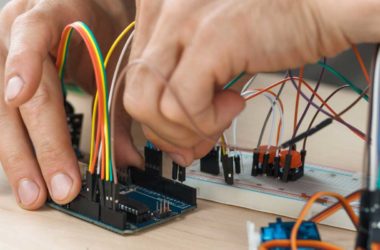Printed circuit boards (PCBs) are used in almost every electronic device available, varying according to application. However, one consistent in all applications is that PCBs require some form of protection against the surrounding environment.
As PCBs are instrumental to the functioning of an electronic device, foregoing protection can be detrimental to the performance and lifetime of the equipment. Coatings and resins provide protection from:
- Water/moisture
- Vibration
- Physical shock
- Thermal shock
- Contamination
Regardless of the type of protection sought, all PCBs must be thoroughly cleaned to ensure that surface contamination does not affect the protection levels provided by the coating or resin.

Conformal coatings
A conformal coating is a thin film that can be applied to a PCB to offer protection from hazardous environments. Such coatings offer effective chemical and thermal resistance for short exposures. They “conform” to the contours of a board allowing for excellent protection and a thorough coverage to extend the working life of the PCB.
The thickness of this coating will fall between 25-100 microns, adding a slight increase in weight to the component. As a relatively thin film, this coating applies little stress upon components which is hugely advantageous for delicate and fragile equipment. Typically the film will be transparent, enabling users to identify the PCB beneath with ease.
Most coatings are 1K (single component) systems, offering a long bath life, low curing temperature and short drying time. Reworking the coating and replacing components is simple to do with conformal coatings. Coatings can be applied manually with a paint brush, spray gun or by being dipped. However, increasingly, robotic systems are being used to provide a more precise and consistent application.
Encapsulation resins
Encapsulation resins are designed to protect and insulate PCBs and components from harsh and challenging environments by encapsulating the device and creating a barrier. When applied to PCBs resins can be 0.5 mm + thick, often being applied much more thickly than this. As a result, resins can cause a significant increase in weight often resulting in a higher price per unit than coating.
Resins are typically 2K (two component) systems where a resin and a hardener are mixed to form a cross-linked polymer. Resins have a much higher viscosity than coatings and are designed to cure at room temperature. However, by applying heat to the resin, the cure time can be reduced. As most curing reactions are exothermic, where too much resin is applied the heat produced during the curing process can cause the PCB to overheat and even catch fire.
By using a resin, greater protection can be afforded to the PCB especially in the event of a chemical attack or in scenarios where the component is immersed for longer periods of time. Resins can also offer protection against physical shock as the bulk of the resin can help to dissipate the force. Unlike coatings, resins can be very dark in colour so that when applied, the PCB beneath is completely hidden, creating a degree of security in the design. However, it is worth noting that when resins are removed, this can lead to the destruction of the PCB.
| Properties | Conformal coating | Resin |
|---|---|---|
| Protection | Lower | Higher |
| Thickness | 25-100 microns | 0.5+ mm (often much thicker) |
| Weight | Minimal increase | Substantial increase |
| Stress on components | Very little | Substantial stress |
| Coating systems | 1K (single component) | 2K (two components) |
| Rework | Yes | No |
Things to consider prior to choosing PCB protection
1. PCB enclosures
If the PCB is contained within a housing enclosure that is designed as its primary protection, then a conformal coating will suffice as back-up protection. This is ideal in the event of damage or a leak and can provide protection against humidity and condensation. If the housing is not capable of providing protection from the environment then a resin will be a more appropriate choice.
2. Environment
Often used in high voltage electronics and explosive environments, resins provide a total dielectric layer to prevent arcing. In such an environment, thinner conformal coatings will be far less effective. However, for delicate components in environments that require limited levels of protection, coatings are likely to suffice.
3. Weight
It is important to determine if the weight of the PCB is a factor in the end goal of the design. When applying a coating the amount of weight added is minimal but when using a resin the additional weight can be substantial.
4. Rework
For applications where rework to the PCB may be required at a later date, conformal coatings will be the most appropriate choice. Coatings can be removed far more easily than resins which, when removed, may destroy the PCB beneath.
Why Electrolube?
Integral to the manufacture and maintenance of electronic components, Electrolube products are ideal for a number of industries including automotive, industrial electronics, consumer electronics and medical sectors. Specialists in conformal coatings and encapsulation resins, Electrolube is at the forefront of innovation in this area.
Recommended products
Black Polyurethane Resin 250g
This two-part black encapsulation resin is formulated to perform to the highest levels with excellent resistance to sea water, good adhesion to most substrates and tear resistance.

Conformal Coating 200ml
This acrylic conformal coating is fast drying and durable, offering excellent electrical properties and good adhesion for a number of applications. This coating is mould resistant and can be reworked with ease.












